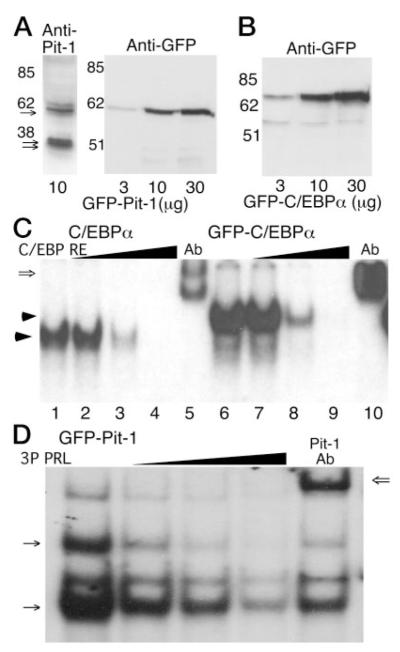Fig. 2.
Analysis of the Expression and the DNA Binding Characteristics of GFP-Pit-1 and GFP-C/EBPα
A, Western blot analysis of proteins extracted from GHFT1–5 cells transfected with the indicated amount of the GFP-Pit-1 expression plasmid. The transferred proteins were probed with either an antibody against Pit-1 (left panel) or an anti-GFP antibody (right panel). The anti-Pit-1 antibody detected both the doublet for endogenous 31- and 33-kDa Pit-1 proteins (double arrows) and the expressed 60 kDa GFP-Pit-1 (arrow), whereas the GFP antibody detected the 60-kDa GFP-Pit-1. B, Cell extracts from GHFT1–5 cells transfected with the indicated amount of the GFP-C/EBPα expression plasmid were subjected to Western blot analysis using the anti-GFP antibody. The GFP antibody detected the 70-kDa GFP-C/EBPα fusion protein. C, EMSA showing that untagged C/EBPα (lanes 1–5) and GFP-C/ EBPα (lanes 6–10) have similar DNA-binding characteristics. Cell extracts were prepared from GHFT1–5 cells expressing the indicated protein, and samples were incubated with a labeled C/EBPα response element (16) as described in Materials and Methods. After gel electrophoresis a single DNA-protein complex was observed (arrow). Binding specificity was demonstrated by competition with an excess of unlabeled oligonucleotide (lanes 2–4 and 7–9), and the presence of C/EBPα in the complex was verified by a shift in mobility resulting from the addition of an antibody specific for C/EBPα (open arrow, lanes 5 and 10). D, Cell extracts were prepared from 3T3-L1 cells expressing GFP-Pit-1, and samples were incubated with a labeled PRL 3P Pit-1 response element as described in Materials and Methods. GFP-Pit-1 formed two distinct complexes (arrows) with the PRL 3P DNA-element. Probe specificity was demonstrated using 3- to 100-fold excess unlabeled oligonucleotide (wedge) and mobility shift with addition of a Pit-1-specific antibody. Other DNA-protein complexes relate to ETS-protein binding to the 3P DNA element (18).

